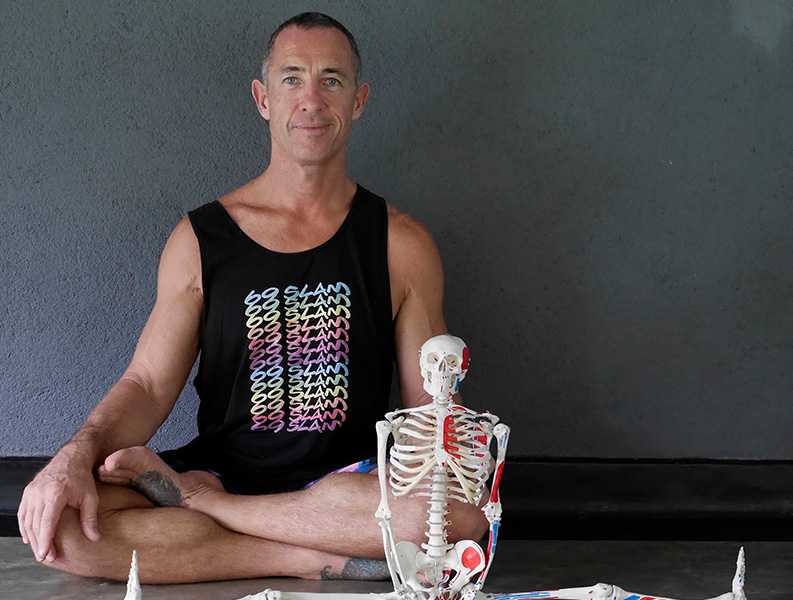Yoga Anatomy Workshop with Stu Girling
5. – 6. Mai 2018
Stu Girling, einer der besten Anatomie Lehrer weltweit, kommt wieder nach Wien. Im Rahmen eines Wochenend-Workshops bietet Stu einen lebendigen und praxisorientierten Einblick in anatomische Zusammenhänge während der Yogapraxis. Dabei verwendet er verschiedene Materialien, Demonstrationen und Gruppenübungen, die Anatomie anschaulich, spannend und greifbar machen. Dieser Workshop ist für alle Levels geeignet und richtet sich an Yogis und YogalehrerInnen aller Stile.
Wenn du mehr über Yoga-Anatomie erfahren möchtest und deinen einzigartigen Körper besser verstehen möchtest, solltest du diesen sehr empfehlenswerten Workshop mit dem charismatischen Lehrer Stu nicht verpassen!

Details
Datum
5. – 6. Mai (Sa-So)
Kosten
€ 200 (full weekend)
€ 55 (per workshop)
Ort
Yogamelange, Thaliastraße 2 im Hof, Top 11-12, 1160 Wien
Booking & Info
Marija +43 699 171 098 83
E-Mail: info@yogamelange.at
`Working with What You’ve Got`
The sort of workshops Stu offers come under the title of “Working with What You’ve Got” and are arranged relating to the major joints of the body (Ankles, Hips, Shoulders/Wrists and Spine) and associated posture groups (Forward Folds, Hip rotations, Backbends, Shoulders, Twists and Binding). The workshops introduce anatomical concepts in an accessible and fun way and are very practically based with the intention of allowing students to discover those muscles and areas of the body that are restricting them and demonstrating ways that they can work on those areas with more specificity.
Workshop Program
Saturday, 5th May
10:00-12:30 BREATH WORKSHOP: In this workshop we will start by exploring the mechanics of breathing, looking at both the internal workings and the visible external shape changes to the ribcage and belly. From there we can easily then apply those concepts to asana. We will also consider how breath influences the nervous and circulatory systems, the effects of manipulating the breath when doing various pranayama practices and play with the various options when linking movement and breath.
14:30-17:30 WS UNRAVELLING THE GATEKEEPERS : In Ashtanga Yoga there are particular postures that are often referred to as ‘gatekeepers’ because they frequently halt the progression through the series of even the most enthusiastic and determined student. In other styles as well there would be postures in any given sequence that might be considered peak postures, providing extra challenges for the student. Presupposing that the student has the technical knowledge to perform the particular posture, sometimes the difficulty is a strength thing, sometimes a missing range of motion (ROM) or easily a combination of both, maybe balance or even fear enter into the equation. In this workshop we single out some of the more tricky postures such as Bujipidasana, Marichyasana B & D, Supta Kurmasana and Pasasana as vehicles for understanding how to deconstruct difficult postures into understandable elements that can then be worked on individually or used as the basis for sensible lead in sequencing. If time allows we will also open up the discussion to include postures being worked on by individuals at the workshop. Of course what will be a peak posture for one person might not present much challenge at all for another depending on their individual make up. Exploration of these more difficult postures allows you to better understand where your restrictions and weakness might be as they are less easily accommodated or avoided in these situations
Sunday, 6th May
11:00-13:30 WS SPINE & SI JOINT: It is not uncommon for students to feel a degree of discomfort when performing backbends or when embarking on taking on some of the more challenging foot behind head postures. By understanding the construction of the spine and the surrounding muscles it becomes evident as to the types of movements that it is designed to perform in certain areas as well as the potential mechanism of injury. We clarify the common spinal injuries such as herniated and bulging discs as well as discuss the possible causes of SI Joint pain. The groups of postures discussed and explored practically are backbends and twists, and the importance of the integration of movements at other major joints of hips and shoulders will be demonstrated. We will endeavour to during the course of the workshop to allow students to determine where their own restrictions are and how to work with them. For those students that feel they are already too mobile we will look at how to build strength and stability.
15:30-18:30 WS FASCIA AND BIOTENSEGRITY : There is lots of interest in the emerging information about fascia and how it might influence the yoga practice. In this workshop we explore what is meant by fascia, what its purpose is and what use we can make of our growing appreciation of fascia. We also look at a proposed model (biotensegrity) for trying to understand how we might incorporate this knowledge into a more comprehensive explanation of human movement and stability. The practical component of this workshop explores connectivity and integrated bodies
Stuart has been teaching yoga related anatomy for the last 7 years both on teacher trainings and international workshops. He has been practicing yoga for 15 years, has a BSc Hons in Health Studies and for the last 10 years has been offering Therapeutic Bodywork exclusively for yoga practitioners.
The underlying philosophy that guides what he shares is that knowledge is of no value unless we can understand how to use it and have use for it. With this in mind the workshops he offers focus on: what makes us individual, how can we understand our limitations and restrictions and how can we avoid injury and create balance.
Stuart endeavours to bring as much fun and practical experimentation into every workshop and emphasises the importance of getting to grips with the concepts rather that getting bogged down in the detail.


